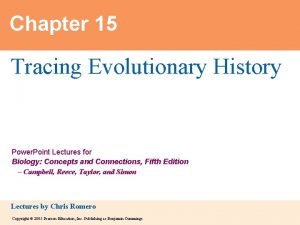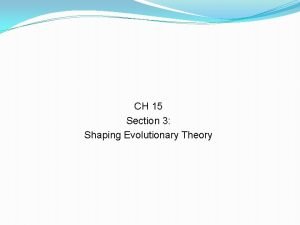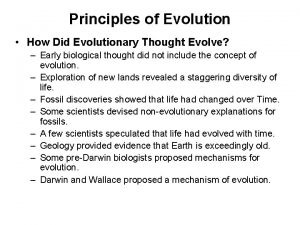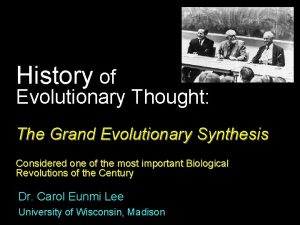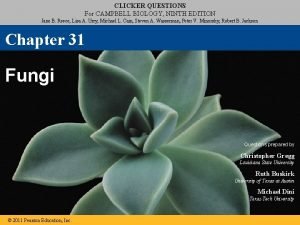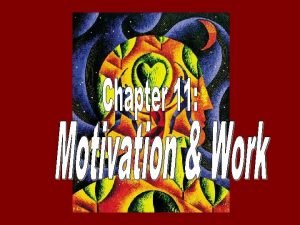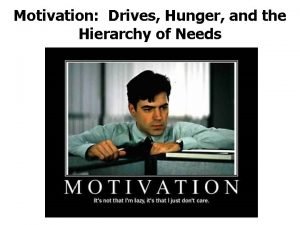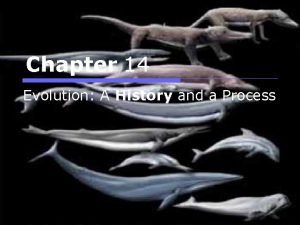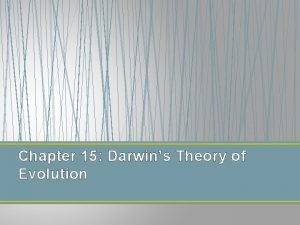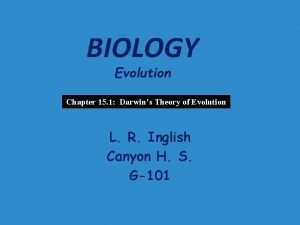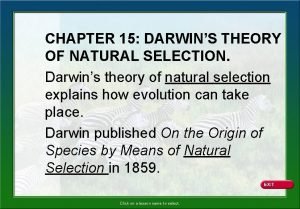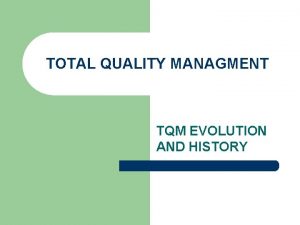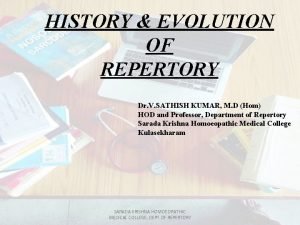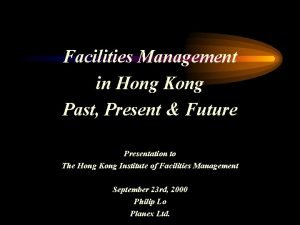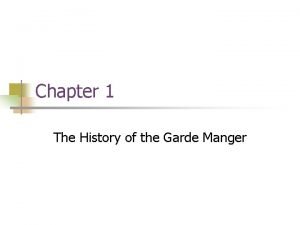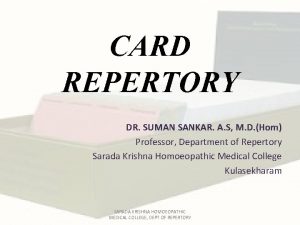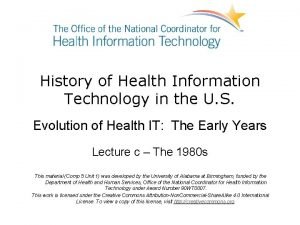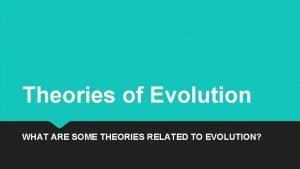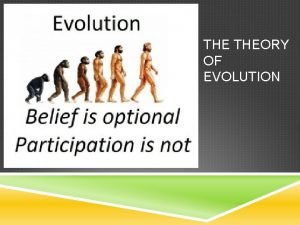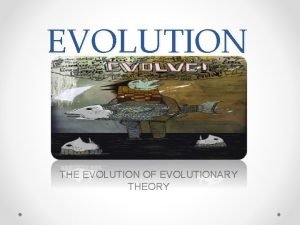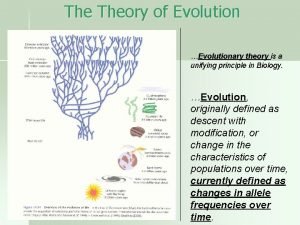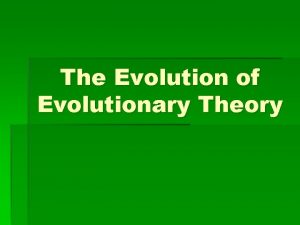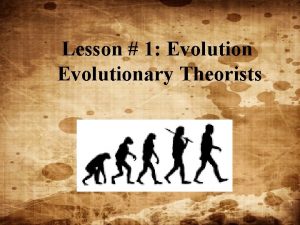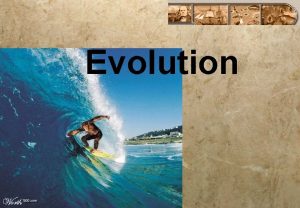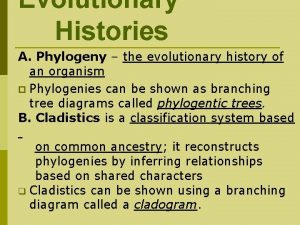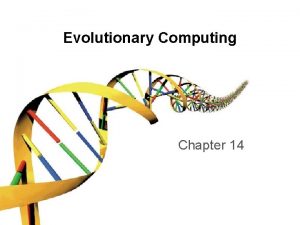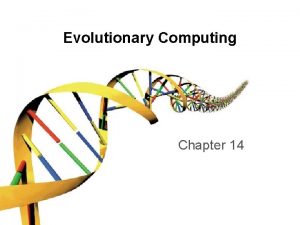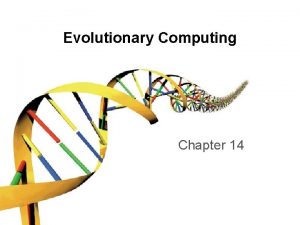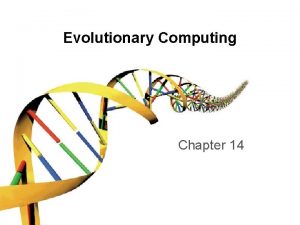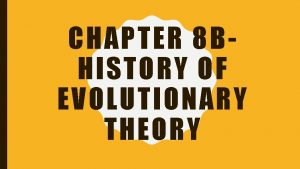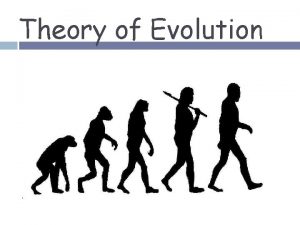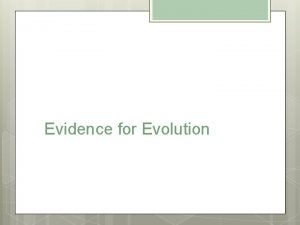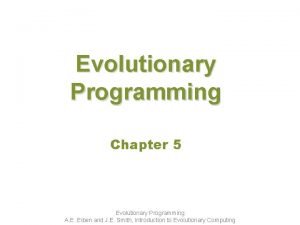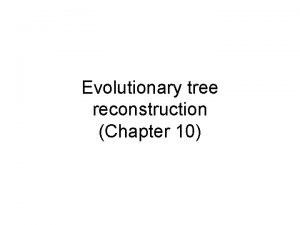Chapter 15 THEORY OF EVOLUTION History of Evolutionary


























- Slides: 26

Chapter 15 THEORY OF EVOLUTION

History of Evolutionary Thought Section 15 -1

History of Evolutionary Thought In 18 th century Europe, it was believed that life had never changed in the few thousand years that life had existed on Earth. However, scientists began studying rock layers (strata) and learned more about geology and living things of the past.

Influential Scientists Cuvier’s Discoveries Lyell’s Idea Some past organisms differ greatly from living species Uniformitarianism Some organisms became extinct BIG IDEA: Geology and life had changed Geologic processes that have changed the shape of the Earth’s surface in the past continue to work in the same ways.

Another Influential Scientist Jean Baptiste Lamarck’s Ideas Simple life forms develop into more complex forms Individuals can acquire traits during their lifetime and pass on those traits to their offspring (inheritance of acquired characteristics)

What does “Inheritance of Acquired Characteristics” Mean? Example: A population of giraffes all had short necks and were able to reach their food. However, when they were forced to move to an area with taller trees, they could no longer reach their food. So they stretched and stretched until they could reach. Then when Mr. & Mrs. Giraffe had babies, their babies had long necks because their parents had acquired long necks.

In other words… The changing environment changes a need and the modification results from that need.

Just because… Louis the Short-Necked Giraffe

Charles Darwin sailed around the world on the H. M. S. Beagle in the mid-1800 s and became the ship’s naturalist. He made observations, kept journals, and collected bones and specimens. He observed that a number of fossil organisms he found were very similar to living organisms. He observed that similar organisms existed in very different locations.

Darwin’s Ideas He described evolution with the phrase “descent with modification, ” meaning that all species descended from preexisting species but changed over time. For example, there are 13 species of finches on the Galapagos Islands, each containing a beak that is best adapted to a certain type of food. He believed that they all descended from a common ancestor.

Darwin’s Finches

The Mechanism for D. W. M. Darwin proposed natural selection as the mechanism for descent with modification. 4 Requirements for natural selection: 1) Overproduction – More offspring produced than can survive 2) Genetic Variation—Individuals in a population have different traits, mostly inherited, sometimes new

Requirements for natural selection 3) Struggle to Survive—Individuals must compete for limited resources, avoid predators, disease, and unfavorable conditions �A trait that makes an individual successful in its environment is an adaptation. 4) Differential Reproduction— Individuals that have certain traits are more likely to survive and reproduce than are individuals that lack those traits. Over time, those traits become more frequent in the population.

Survival of the Fittest Fitness refers to one’s ability to survive to maturity and reproduce. If a certain trait increases one’s fitness, it will likely increase in the population. These are adaptations (e. g. speed, agility).

Evidence of Evolution Section 15 -2

The Fossil Record Oldest fossils tend to be lower in the strata than newer fossils. Based on these strata, we can tell when different organisms lived. We can tell where different organisms lived.

Fossils We can see that species have differed in a gradual sequence of forms over time. This is based on transitional species, which have features intermediate between those of hypothesized ancestors and later descendent species. When looking at transitional species, researchers look at derived traits (newly evolved) and ancestral traits (old, primitive).

Transitional Species

Biogeography Similar species adapted to different environments in the same area Seemingly unrelated species had similar adaptations to similar environments in different areas Some features are only found in one region Example: Most mammals on Australia are marsupials – probably evolved in isolation

Anatomy Homologous structures occur in different species, have a related structure originating with a common ancestor, may have different functions Analogous structures have closely related functions but do not come from a common ancestor Vestigial structures no longer serve the purpose that they did in an ancestor.

Embryology The embryos (earliest stage of fetal development) of many organisms are very similar. This shows that these animals likely had a common ancestor

Biological Molecules We can look at DNA sequence or amino acid sequence to see how closely related organisms are.

ADAPTATION An adaptation is a trait shaped by natural selection that increases an organism’s reproductive success. Fitness is the number of viable offspring that an organism produces, shows how effective a trait is in contributing to reproductive success. Examples: camouflage, mimicry, antibiotic resistance

Evolution in Action Section 15 -3

Patterns of Evolution Divergent Evolution One ancestral species evolves into a number of different species. Adaptive Radiation A type of divergent evolution in which a species evolves into many different species that all fit different parts of the environment. �Ex. Darwin’s finches

Patterns of Evolution Convergent Evolution Different species become more similar due to similar environments
 Section 3 shaping evolutionary theory
Section 3 shaping evolutionary theory Chapter 15 tracing evolutionary history
Chapter 15 tracing evolutionary history Chapter 15 section 3 shaping evolutionary theory
Chapter 15 section 3 shaping evolutionary theory History of evolutionary thought
History of evolutionary thought History of evolutionary thought
History of evolutionary thought Clicker fungus
Clicker fungus Evolutionary theory of motivation
Evolutionary theory of motivation Evolutionary theory of motivation
Evolutionary theory of motivation Refractory period men
Refractory period men Optimal arousal theory
Optimal arousal theory Evolutionary theory of motivation
Evolutionary theory of motivation Chapter 15 darwin's theory of evolution section 15-1
Chapter 15 darwin's theory of evolution section 15-1 Henotheism
Henotheism Chapter 14 evolution a history and a process
Chapter 14 evolution a history and a process Chapter 17 darwins theory of evolution
Chapter 17 darwins theory of evolution Chapter 15 darwin's theory of evolution section 15-1
Chapter 15 darwin's theory of evolution section 15-1 Chapter 15 darwin's theory of evolution section 15-1
Chapter 15 darwin's theory of evolution section 15-1 Chapter 15 darwin's theory of evolution
Chapter 15 darwin's theory of evolution Evolution of total quality management
Evolution of total quality management History and evolution of repertory
History and evolution of repertory Facility management history and evolution
Facility management history and evolution History and evolution of garde manger
History and evolution of garde manger Sharma card repertory ppt
Sharma card repertory ppt History of repertory
History of repertory History and evolution of health information technology
History and evolution of health information technology Lamarck's theory of evolution
Lamarck's theory of evolution What does the theory of evolution state
What does the theory of evolution state

